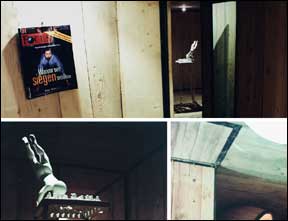Letter from Bucharest: Sculpture and Architecture
In the middle of Bucharest, a well-known art gallery, Simeza, displays the most important Romanian contemporary artists’ works in either single or group exhibitions. Simeza is an old gallery with its own traditions. It has two rooms, not very large, but with high ceilings. Any artist who exhibits his or her works there imagines his or her display in a close relationship with the architecture of this gallery. However, almost all exhibitions are displayed conventionally. In response to this rigidity, Ionel Stoicescu, a young sculptor, recently conceived another kind of art display.
Stoicescu actually modified the configuration of the gallery entirely. Ionel Stoicescu’s first sculpture exhibition, which remained open until the end of September, was actually built inside Simeza gallery from wood, the oldest and most noble material there is.
The artist built a wooden precinct, a labyrinth, inside of the existing precinct of the gallery, altering its well-known, conventional look. Such an architectural approach, as long as the sculpture imposed upon the conventional rooms of the gallery, was anxious and troubling, although only temporary. After two weeks, the space of the gallery returned to its common configuration. Stoicescu’s hard work to build a precinct within a precinct left as its only result some strong impressions. The final destination of the wood used for that building will be some works of sculptures or, maybe, a wooden house, because he used enough wood to build a house.
The room they had found shelteredonly one sculpture: a porcelain object representing an angel surrounded by small ducks. The object was, of course, an ironic commentary on kitsch objects, which almost always “stifle” the rooms where most of the people live. A second room from the wooden precinct could be named “the room of frustrations”. Using the high-tech computer graphic, the artist inserted photos with his portrait in different hypostasis, along with his name on the front page of some famous magazines: Paris Match, Beaux Art, Le Monde, etc. At first sight, it was very difficult for the onlooker to understand that the respective front pages were only a trick, because the first impression is very strong. Frustration and self-irony are often the message of young Romanian artists’ works because they live in an absurd world that has lost normal value systems–a world where the real values are rejected and only imposition leads to a successful career. Like many other young Romanian artists, Ionel Stoicescu dreams to be understood and praised, because he has confidence in his own value.
The third room of the wooden precinct displayed a great portrait of the artist laid on the floor. Any visitor of Simeza gallery might explore the precinct, climbing on its roof also and then sliding on a kind of chute straight along the artist’s portrait. Ionel Stoicescu’s proposal was a game and he invited anyone to play and participate in that unprejudiced show.
Stoicescu’s exhibition, a mixture of sculpture and architecture, thus tried to fight against some conventions concerning art object perception, as well as different types of representation.





